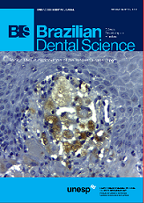The Dynamics of Subcutaneous Tissue Response to Microorganisms Associated with the Extract of Araçá (Psidium cattleianum): An Edemogenic and Microscopic Analysis
DOI:
https://doi.org/10.14295/bds.2017.v20i2.1408Abstract
Objective: To evaluate in vivo tissue reaction to the extract of araçá (Psidium cattleianum) associated with inactivated microorganisms. Material and Methods: A 0.1 mL suspension was used containing Porphyromonas gingivalis, Prevotella intermedia, Fusobacterium nucleatum, Enterococcus faecalis, Peptostreptococcus micros, and Porphyromonas endodontalis, which were inactivated by heat and mixed into a 1.0 mL saline (control group), an aqueous solution, or a hydroalcoholic extract of araçá. Eighteen male rats (Rattus norvegiccus) under general anesthesia received 0.2 mL of 1% intravenous Evans blue. Thirty minutes later, 0.1 mL of one of the associations was injected into the animals’ dorsal region. The animals were euthanized after 3 and 6 hours, and the materials obtained were placed in formamide for 72 hours then analyzed in a spectrophotometer (?=630 hm). For the morphological analysis, 30 rats received polyethylene tubes implants with the extracts or the saline with the associations in the dorsal region and euthanized after 7 and 30 days to be analyzed according to an inflammation cell score. Results: No significant difference (p>0.05) was observed in the edema among groups. The optical microscopy results showed a repair in the 30-day-period, which was higher when compared to the 7-day-period (p<0.0001). Nevertheless, in the 7-day-period, the hydroalcoholic extract presented a significant response compared to the aqueous extract (p=0.05) and a trend for better results than the control group. Conclusion: The aqueous and hydroalcoholic araçá extracts associated with inactivated microorganisms showed similar responses to control, indicating no interference on the toxic effects of the bacterial components in tissue repair.
Keywords
Anaerobic bacteria; Edema; Inflammation; Plant extracts; Psidium.
Downloads
Downloads
Additional Files
Published
How to Cite
Issue
Section
License
Brazilian Dental Science uses the Creative Commons (CC-BY 4.0) license, thus preserving the integrity of articles in an open access environment. The journal allows the author to retain publishing rights without restrictions.
=================




























